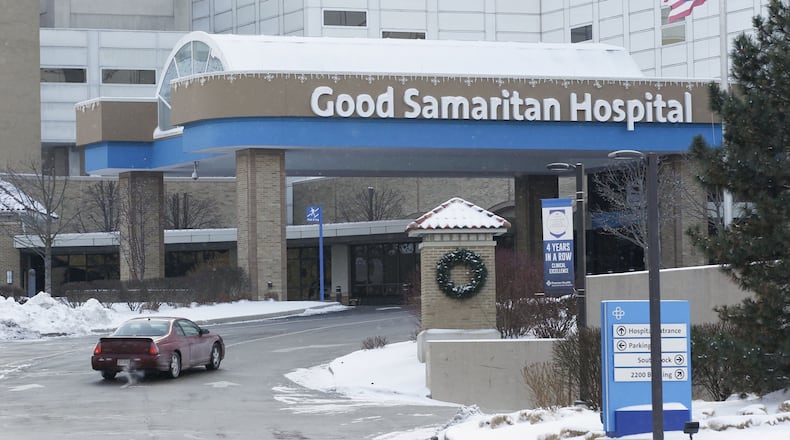The number of overnight hospital stays have been shrinking across the U.S. because of a number of factors, including better technology that lets patients heal faster.
Incentives from insurance companies are also accelerating the change. Pay structures are increasingly designed to reward efforts to limit hospital stays whenever possible and manage disease outside of a hospital setting. The growing prevalence of high-deductible plans also results in more patients shopping for the cheapest alternative.
RELATED: Local leaders ‘saddened’ by announced hospital closing
Premier CEO Mary Boosalis said that both of the network’s hospitals in Dayton are operating at about half capacity, when the goal would be closer to 80 or 85 percent to efficiently use the space but still have flexibility for busier seasons.
“The bottom line is 50 percent utilization implies excess capacity,” Boosalis said.
Unused beds are a major reason why Premier announced Wednesday that it will close Good Samaritan’s main campus by the end of the year.
The move will consolidate services from Good Sam into Miami Valley Hospital and move 1,600 jobs out of northwest Dayton. The Premier Health-affiliated hospital campus at the corner of Philadelphia Drive and Salem Avenue will be torn down and converted into a shovel-ready lot, leaving only the outpatient Five Rivers Health Center and parking garage.
Fundamental changes
Bryan Bucklew, president and CEO of the Greater Dayton Area Hospital Association, which represents nearly 30 hospitals in the region, said hospitals deliver health care in fundamentally different ways than even five years ago.
Insurers are switching the way they pay hospital networks to reward quality health outcomes and penalize for preventable admissions. National programs like with Centers for Medicaid and Medicare are pushing hospitals to lower length of hospital stays or prevent hospital stays altogether.
“There’s been well over a decade of concentrated incentives and partnerships with local providers on how to get patients more healthy and out of the hospital,” Bucklew said. “How to get the right care, at the right time, in the right facility. There’s been specific changes in emphasizing not to fill hospital beds but how to prevent hospitalization.”
RELATED: 5 things you need to know about Good Samaritan Hospital in Dayton
Even with an aging U.S. population and a rising prevalence of chronic disease, hospital inpatient stays nationally dropped 6.6 percent between 2005 and 2014, according to the latest data from the Agency for Healthcare Research and Quality. Surgical inpatient stays alone dropped 12 percent over the same time frame.
Dr. Tammy Lundstrom, Premier Health chief clinical officer, said more patients are managing their health care and recovery outside of a hospital, such as with home health care.
“As technology gets better, we’re able to care for much sicker patients at home with home care and in other settings,” she said.
‘Treatment of last resort’
The average length of a hospital stay declined from about 11 days in 1975 to a little more than six days in 2010. Recent reports have put the average closer to three or four days.
At Wright-Patterson Air Force Base, Bucklew said the base hospital has maybe 25 to 30 percent fewer beds than the old facility did, an indication of how health care is changing.
“When I started 12 years ago, hospitals were the revenue centers and the goal was ‘how to do we fill up their beds.’ Now the emphasis is ‘how do we give the right care, at the right time, in the right facility,’” Bucklew said, adding that inpatient hospital stays are now a “treatment of last resort.”
Another factor that has affected inpatient bed stays is the growing number of adults with high-deductible health insurance plans. The Centers for Disease Control reported about 39 percent of adults with employer-based coverage had high-deductible plans, compared to 26 percent in 2011. Patients with these plans are more financially motivated to shop for treatment in cheaper settings and forgo elective surgery.
Building boom
While there has been a burst of new construction in the Dayton area, the region has about 4 percent fewer licensed hospital beds than 10 years ago. Many of those beds, too, are not being used.
RELATED: Premier Health, UnitedHealthcare have contract deal
Construction of patient towers, which occurred at Miami Valley Hospital and Dayton Children's Hospital, didn't necessarily add beds. Boosalis said the $135 million, 12-story addition at Miami Valley that opened in 2011 allowed the hospital move patient beds to private rooms, which are preferred by consumers and easier to control for infections.
Most of the hospital network construction in the region has been to build settings like urgent care centers, freestanding ERS and primary care. And a lot of this expansion has occurred in suburban locations where the population is growing.
Hospitals like Good Sam are expensive to operate.
Premier Health officials said it would cost $90 million or more to keep the campus up to code over the next decade. Premier will also save about $7 million to $8 million annually in operating costs by shifting services to other hospitals, officials said.
Melissa Thomasson, a health care economist at Miami University, said hospitals don’t get less expensive just because the patient population declines.
“An empty bed costs just as much money as a bed that’s being used,” she said.
RELATED: Sale of Premier Health’s insurance line falls apart
By the numbers: Hospital stays
4,082: Total regional licensed beds in 2006
3,922: Total regional licensed beds in 2016
11.4: Average U.S. length of hospital stay in 1975
6.2: Average U.S. length of hospital stay in 2010
Sources: Greater Dayton Area Hospital Association; Centers for Disease Control and Prevention
About the Author




